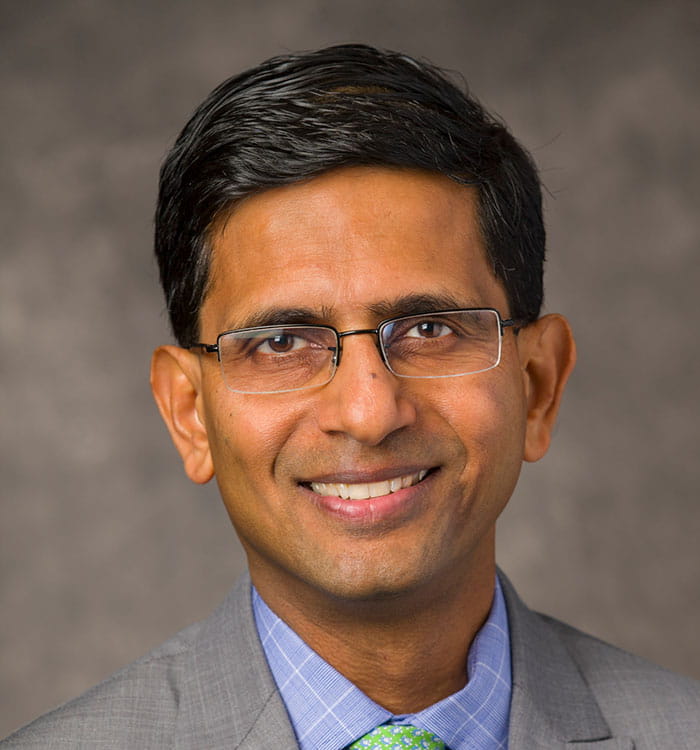What Do a Gila Monster and an Apple Tree Have to Do with Heart Disease?
November 24, 2019
New Multidisciplinary Center at UH is aggressive in using new drugs to prevent cardiovascular complications of diabetes
Innovations in Cardiovascular Medicine & Surgery | Fall 2019
 Sanjay Rajagopalan, MD
Sanjay Rajagopalan, MD
The saliva of the Gila monster and the bark of the apple tree have revolutionized care for patients with cardiovascular complications of diabetes over the past several years.
“There are two molecules from these sources that were developed very serendipitously: SGLT2 inhibitors and GLP1 analogs,” says cardiologist Sanjay Rajagopalan, MD, Chief of the Division of Cardiovascular Medicine at UH Harrington Heart and Vascular Institute; and Professor of Medicine, Case Western Reserve University School of Medicine. “These two drugs have been shown to be very beneficial in diabetes, and they don’t require an endocrinologist to prescribe them. These are really cardiovascular drugs. They really work by reducing heart attack and strokes, as well as mortality in heart failure.”
“Over the last five years, there’s been remarkable progress in preventing cardiovascular complications for diabetics,” he adds. “The important thing about these medicines is that they reduce mortality. There’s never been a drug for diabetes, including insulin, which has been used for decades now, that’s ever been shown to reduce mortality. SGLT2 inhibitors can reduce heart failure by 36 percent. They also reduce renal complications of diabetes by nearly 42 percent. The other drugs, GLP1 analogs, work by reducing weight and reduce heart attacks and strokes.”
To better implement these advances with diabetic patients, UH and Dr. Rajagopalan have established a new multidisciplinary center encompassing cardiology, nephrology, endocrinology and advanced imaging, with support from UH dietitians and exercise physiologists to support patients in their wellness efforts. Dubbed CINEMA (Center for Integrated and Novel Approaches in Vascular-Metabolic Disease), its goal is to leverage multiple pre-existing partnerships and collaborations within and outside of UH to create an integrated program focused on better understanding and treatment of cardiac and vascular complications of Type 2 diabetes.
“It is anticipated that the CINEMA’s efforts will lead to development of better methods for detection of sub-clinical vascular disease, therapeutics for the treatment and technology-based approaches to improve the lives of patients with diabetes and cardiovascular complications, through implementation science and personalized medicine,” Dr. Rajagopalan says.
According to Dr. Rajagopalan, cardiologists are uniquely positioned to take advantage of what he calls the “huge, seismic shift in the landscape of diabetes care” through centers like CINEMA.
“This is becoming part and parcel of what cardiologists do,” he says. “Most patients who come into cardiology who are diabetic or pre-diabetic ought to be treated aggressively. Cardiologists are very good with prevention – we already work with lipids, we already work with blood pressure. Now we’ll add diabetes to the whole story. The bottom line is that we want the buck to stop with the cardiologist.
Joining Dr. Rajagopalan in CINEMA is the UH Chair of Family Medicine, Goutham Rao, MD, as well as several other UH physicians. Patients will be seen at an outpatient location on the East side of the UH system initially, with plans to expand to another location or two in other parts of the service area in the future. The goal is to create a one-stop, frictionless experience for patients
“We feel that a center like CINEMA that allows us to do that effectively would really mean a lot to a diabetic patient,” Dr. Rajagopalan says.
With the advent of SGLT2 inhibitors and GLP1 analogs, there has been increased interest in the cardiology community in establishing multidisciplinary centers to better coordinate care for diabetic patients. But UH is among the first to put these ideas into action.
“We are at the forefront,” Dr. Rajagopalan says. “There has been a lot of talk in the field for years, but few places have taken the initiative to make a center like CINEMA a reality.”
For more information about CINEMA, please contact Dr. Rajagopalan at 216-553-1439 or email Sanjay.Rajagopalan@UHhospitals.org.


